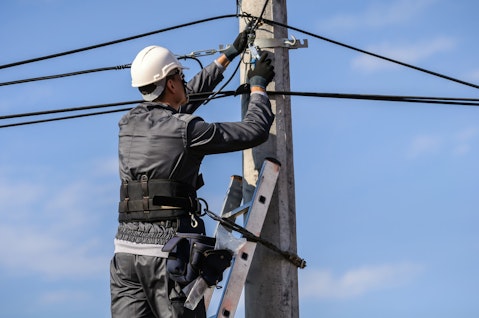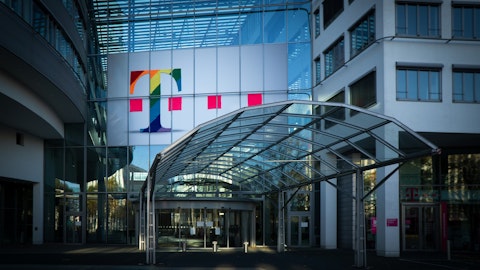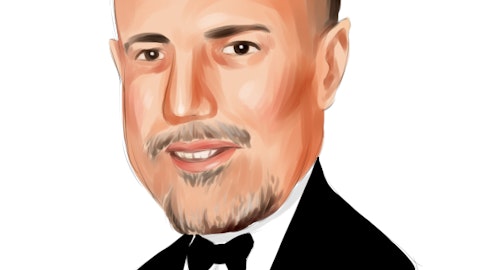América Móvil, S.A.B. de C.V. (NYSE:AMX) Q2 2023 Earnings Call Transcript July 12, 2023
Operator: Good morning. My name is Nadia and I’ll be your conference operator today. At this time, I would like to welcome everyone to the America Movil Second Quarter 2023 Conference Call and Webcast. All lines have been placed on mute to prevent any background noise. After the speakers’ remarks, there will be a question-and-answer session. [Operator Instructions] Thank you. Now I will turn the call over to Mr. Daniel Hajj, CEO of America Movil to begin. Thank you.
Daniel Hajj: Thank you, Nadia. Welcome, everyone. Thank you for being in the America Movil second quarter of 2023 financial and operating report. Carlos is going to make a summary of the results. Carlos, please.
Carlos Garcia Moreno: Thank you, Daniel. Good morning, everyone. During the second quarter, US dollar interest rates remained as volatile as they had been in the first quarter with inflationary pressures stronger than anticipated earlier in the year, the reduction of interest rates by the Fed originally expected to take place in the latter part of 2023 appeared increasingly improbable, giving rise to an upward trend in medium and long-term rates throughout the latter half of the quarter that has continued in July. We added 2.2 million wireless subscribers in the second quarter, including 1.5 million postpaids. Brazil contributed 632,000, Austria 267,000 and Colombia 171,000. Prepaid net subscriber additions stood at 787,000 with Brazil and Mexico adding almost 200,000 each, and Colombia 185,000.

Kappri/Shutterstock.com
On the fixed-line segment, we obtained 331,000 broadband accesses, including 140,000 in Mexico, practically identical to the figures in the prior quarter which makes it the second consecutive quarter with strong broadband net additions, 78,000 in Argentina and 45,000 in Brazil. The growth of our mobile subscriber base stayed basically on trend with the postpaid base expanding 8.3% and the prepaid one 5.3%. On the fixed-line platform, broadband access growth picked up a bit to 3% while PayTV accesses remained roughly flat. Second quarter revenue was down 4.6% year-on-year to MXN203 billion, in Mexican peso terms, with service revenues falling 4.2%. As in the prior quarter, this reflected the appreciation of the Mexican peso versus other operating currencies in the period.
Correcting for foreign exchange effects, service revenue increased 5.0% at a slightly slower pace than that of the prior quarter. EBITDA was down 3.8% in Mexican peso terms to MXN78.7 billion in the quarter, representing a 38.9% EBITDA margin. At constant exchange rates, it expanded 5.6% in the period, reflecting the greater operating leverage of the company. With EBITDA growing faster than revenue, the reduction in inflation rate we have seen in most countries as well as the appreciation of most Latam currencies and the euro vis-a-vis US dollar have recently contributed to this through their impact on costs. Service revenue growth continued to advance on the fixed-line platform, moving up to 2.3% at constant exchange rates from 1.8% in the prior quarter.
On the mobile platform, it slowed down to 6.7% from 9.3% in the prior quarter. The improvement of fixed-line service revenue growth was observed in three of our four principal markets, Mexico, Brazil and Austria. In Mexico, it was driven by both corporate network services and fixed broadband services in Brazil and Austria, by the latter. Importantly, the downward trend of PayTV revenue appears to be coming to an end. In the quarter, they were down 1.3%, the lowest decline in several quarters. The deceleration of mobile service revenue growth stems principally from the normalization of mobile revenue in Brazil exactly a year after the integration of revenue from former Oi mobile clients acquired by Claro. The uplift in terms of revenue growth provided by former Oi clients has come down to 0.8% from 6.4% a year ago.
In addition to the above, we also had somewhat slower growth in Mexico and Colombia. EBITDA yearly increases were in the neighbourhood of 9% in Brazil, Eastern Europe, Peru and Ecuador followed by Mexico at 5.1% and Austria at 4.3%. Our operating profit in the quarter MXN40.3 billion was down 2.9% year-on-year with our net profit nearly doubled from the earlier quarter to MXN26 billion, mostly on account of greater foreign exchange gains. In the first six months of the year, capital expenditures totaled MXN64 billion and distribution to shareholders MXN3 billion, including share buybacks. In cash flow terms, we reduced our net debt by MXN4 billion in the period. All the above was funded by our operating cash flow and by proceeds from the sale of certain shares and payment received of the sale to sale of our interest in platform.
Our net debt excluding leases totaled MXN356 billion at the end of June, having come down by MXN25.8 billion from the end of December on the back of the appreciation of the Mexican peso vis-a-vis other currencies, particularly the dollar. It was equivalent to 1.43 times EBITDA. So with this summary of our results, I would pass the floor back to Daniel Hajj for the Q&A session. Thank you all.
Daniel Hajj: Thank you, Carlos.
See also 15 Franchises That Run Themselves and 15 Free International Dating Sites Without Payment.
Q&A Session
Follow America Movil S A B De C V (NYSE:AMX)
Follow America Movil S A B De C V (NYSE:AMX)
Operator: Thank you. [Operator Instructions] Our first question goes to Vitor Tomita of Goldman Sachs. Vitor, please go ahead. Your line is open.
Vitor Tomita: Good morning, all, and thank you very much for your question — for allowing us to have some questions. The first question from our side would be on share buybacks. If you could give us an update on how you are thinking about buybacks for the second half of the year, especially considering that we noticed the slower pace of buybacks year-to-date. And on how further buybacks will be funded given that you mentioned that dividends from Verizon and KPN were a source of funding for shareholder remunerations thus far? Also second question from us on M&A. Now that you have achieved a more comfortable leverage position and are generating cash consistently, could you provide us an update on your M&A strategy and on which regions could potentially be considered for further acquisitions? Thank you very much.
Carlos Garcia Moreno: Okay. Well, on the share buybacks, as we’ve mentioned in prior calls, we tend to have them all kind of with our cash flow throughout the year. The cash flow the first half of the year is seasonally weak because we need a lot of working capital and then we usually get it back in the second half of the year. So that’s where we have a bit more liquidity that we can engage in more shareholder distributions. In the case of — so beyond the issue of the seasonality, that’s been there always, I think that this year we have mentioned in the prior calls, we needed to accommodate the increase in CapEx that we had mentioned to you. We had increased the CapEx from MXN8 billion in the original budget to MXN8.5 billion more or less and that’s basically what we wanted to cover before we could actually engage in pulling share buybacks.
I think that now we will be going back to normal. I think, that we should expect to resume distributions very much along with the recovery of our cash flow. In terms of our M&A, I think, that we are not currently looking at anything anywhere. I think that we have a lot of growth, organic growth to develop and we have been saying in some of the numbers, some of the fixed-line operations are developing very nicely and we are continuing to have a good growth on mobile. So it’s not that we need to buy growth anywhere, I think that there is a plenty to develop organically. Overly, out of regulatory concerns, there’s a few entities that one could acquire, certainly in Latin America that’s the case. And in Eastern Europe, I think that it’s also because there’s not that many more assets to buy.
So I don’t think that we are looking really today at anything outside our footprint and within our footprint respectively no entities that we could buy.
Daniel Hajj: And just to add on what Carlos said is, I think the additional CapEx that we’re putting we’re seeing good opportunities in Latin America growth opportunities and that’s what we’re looking for. So I think this year we can put more fiber or other investments in some countries that I think we’re going to get good growth. And on M&A, as Carlos is saying, but we are open to see other opportunities, but right now we’re not looking to anything.
Vitor Tomita: Very, very clear. Thank you very much.
Daniel Hajj: Thank you.
Carlos Garcia Moreno: Thank you.
Operator: Thank you. The next question goes to Lucas Chaves of UBS. Lucas, please go ahead. Your line is open.




